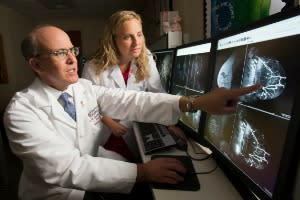By David Gruen, MD, MBA, Director of Women’s Imaging & Co-Director, Breast Center and Helen Pass, MD, Director of Breast Surgery and Co-Director, Breast Center
The best way to protect women from breast cancer is to find it early – and the only way to do that is through annual screening mammography – from age 40 on.
At Stamford Health, we know there are many myths surrounding medical conditions and treatments. One such myth is that if a woman has no family history of breast cancer, she isn’t at risk. Because we’re unable to identify such a vast majority of women who are clearly at risk for breast cancer, we must be diligent in our efforts to protect all women.
Breast cancer accounts for 29% of female cancers, and affecting 1 out of every 8 women in her lifetime. Unfortunately, approximately 75% of breast cancers diagnosed each year in the United States are invasive, dramatically increasing the risk of mortality if not detected early.
The most effective method is screening mammography. We know that 95% of breast cancers occur after the age of 40. We also know that 1 out of every 6 is found in women between the ages of 40 and 49. Simply put, annual screening mammography for every women age 40 and above is the best advice we can give. We strongly disagree with the idea that finding breast cancer before age 45 or after age 55 is less important. Plus, for women 50 and over, having a mammogram only every other year would miss up to 30% cancer detection.
That brings us to our next point: addressing the confusion about mammograms. So what do we tell those who are being inundated with statistics, recommendations, and warnings through a media blitz? Your confusion is certainly understandable. Is it age 40 or age 50? Is it every year or every two years? Or is it some combination? The questions and misinformation abound. But through it all, one thing remains and irrefutable since 1990: mammography has helped reduce breast cancer mortality in the U.S. by 1/3. The best way to protect any woman from breast cancer is to find it early—and the only way to do that is through annual screening mammography.
Did you know:
- Breast cancer is the most common form of cancer in women.
- More than 3 out of every 4 women diagnosed (75-85%) have no family history or known risk factors.
- Risk increases significantly beginning at age 40 and continues to rise as you get older.
- Left untreated, even for one year, breast cancer can spread and become more dangerous, requiring more invasive treatment.
Schedule a Mammogram
Get Same-Day Results During Business Hours
Call 203.276.PINK (7465)
Call 203.276.PINK (7465)
The best way to protect women from breast cancer is to find it early – and the only way to do that is through annual screening mammography – from age 40 on.
At Stamford Health, we know there are many myths surrounding medical conditions and treatments. One such myth is that if a woman has no family history of breast cancer, she isn’t at risk. Because we’re unable to identify such a vast majority of women who are clearly at risk for breast cancer, we must be diligent in our efforts to protect all women.
Breast cancer accounts for 29% of female cancers, and affecting 1 out of every 8 women in her lifetime. Unfortunately, approximately 75% of breast cancers diagnosed each year in the United States are invasive, dramatically increasing the risk of mortality if not detected early.
The most effective method is screening mammography. We know that 95% of breast cancers occur after the age of 40. We also know that 1 out of every 6 is found in women between the ages of 40 and 49. Simply put, annual screening mammography for every women age 40 and above is the best advice we can give. We strongly disagree with the idea that finding breast cancer before age 45 or after age 55 is less important. Plus, for women 50 and over, having a mammogram only every other year would miss up to 30% cancer detection.
That brings us to our next point: addressing the confusion about mammograms. So what do we tell those who are being inundated with statistics, recommendations, and warnings through a media blitz? Your confusion is certainly understandable. Is it age 40 or age 50? Is it every year or every two years? Or is it some combination? The questions and misinformation abound. But through it all, one thing remains and irrefutable since 1990: mammography has helped reduce breast cancer mortality in the U.S. by 1/3. The best way to protect any woman from breast cancer is to find it early—and the only way to do that is through annual screening mammography.
Featured Expert/ Author



